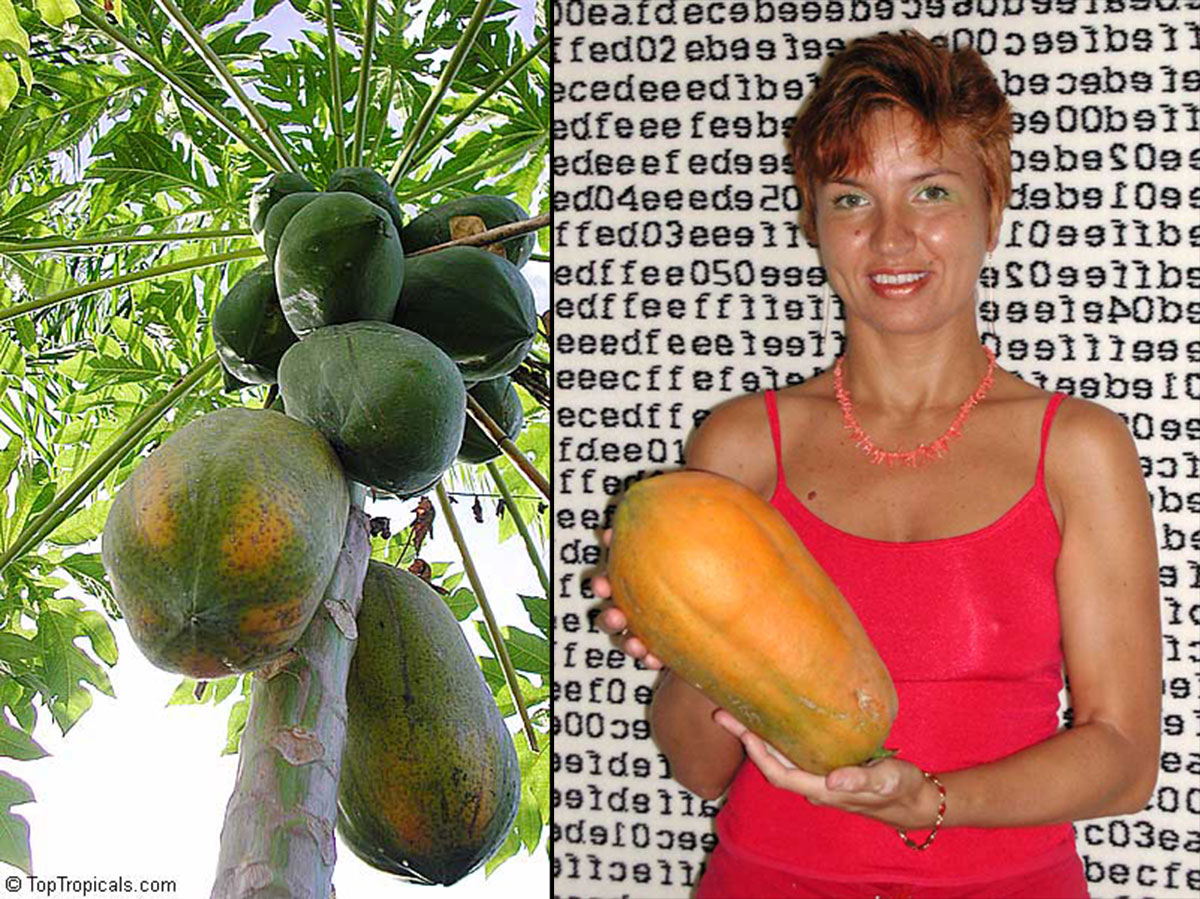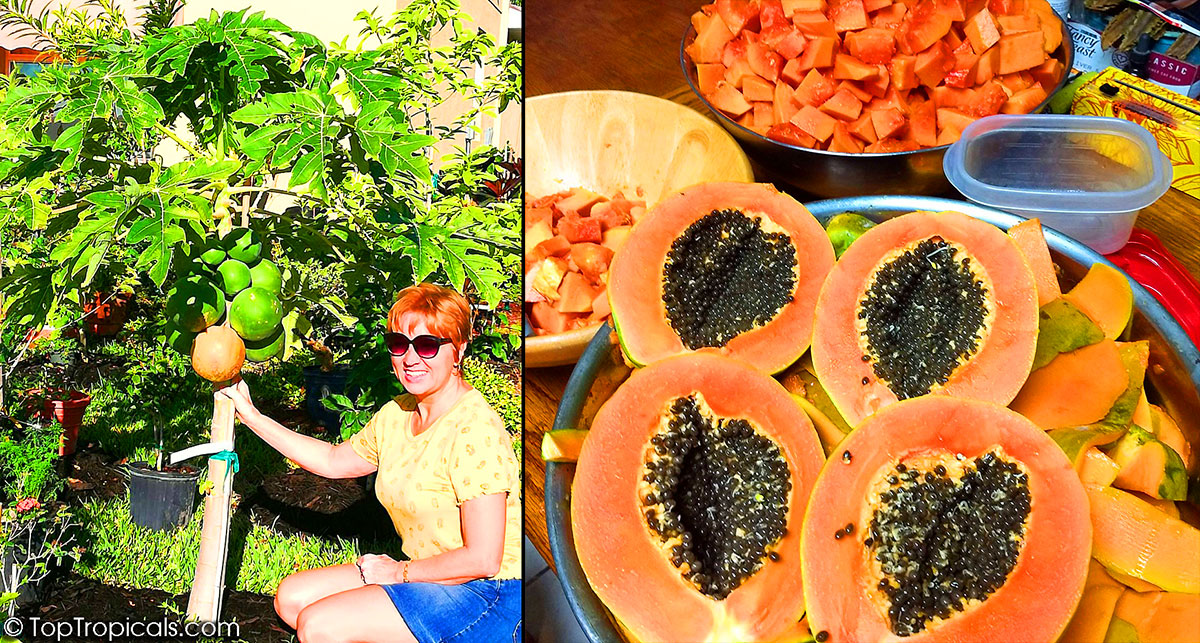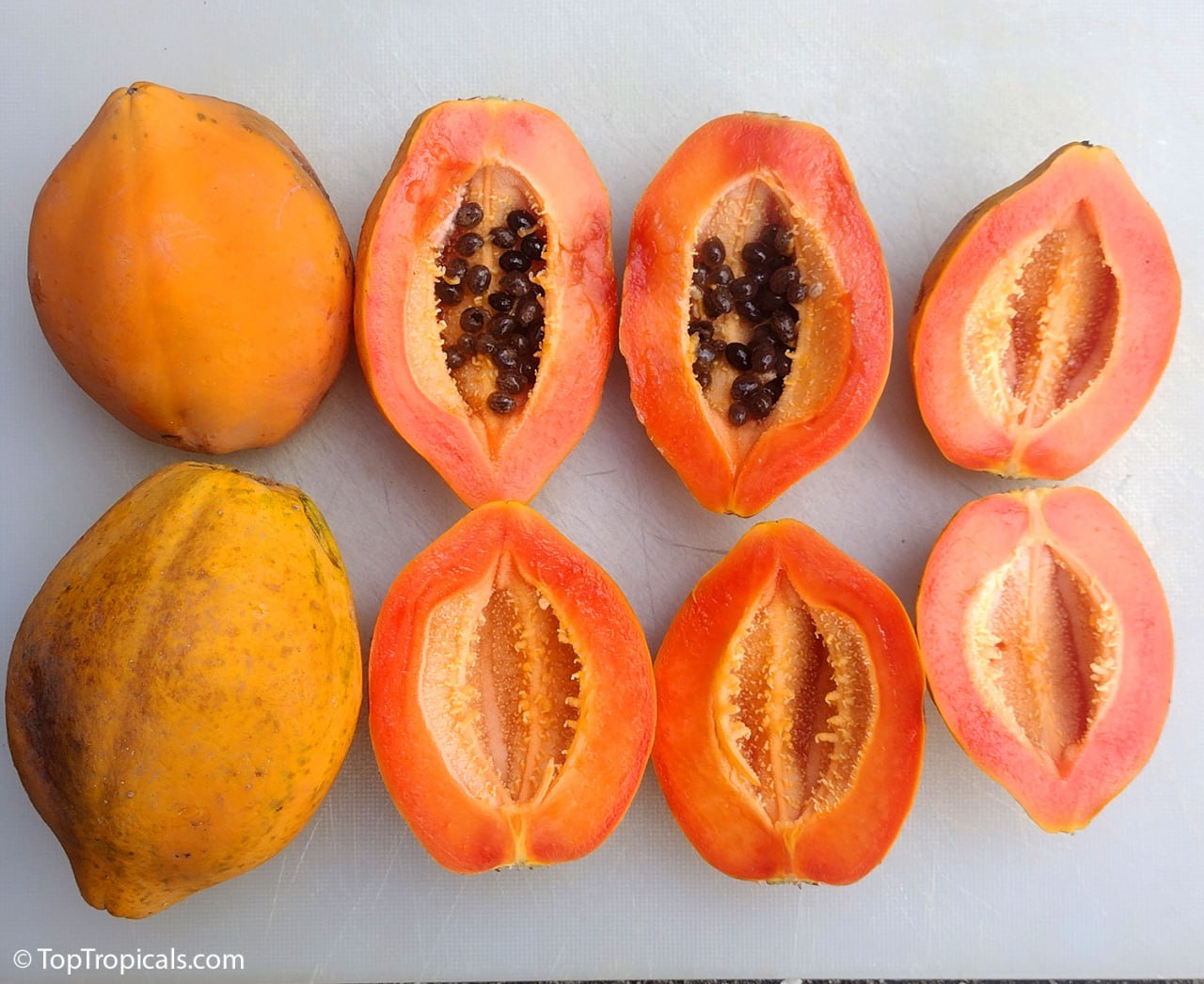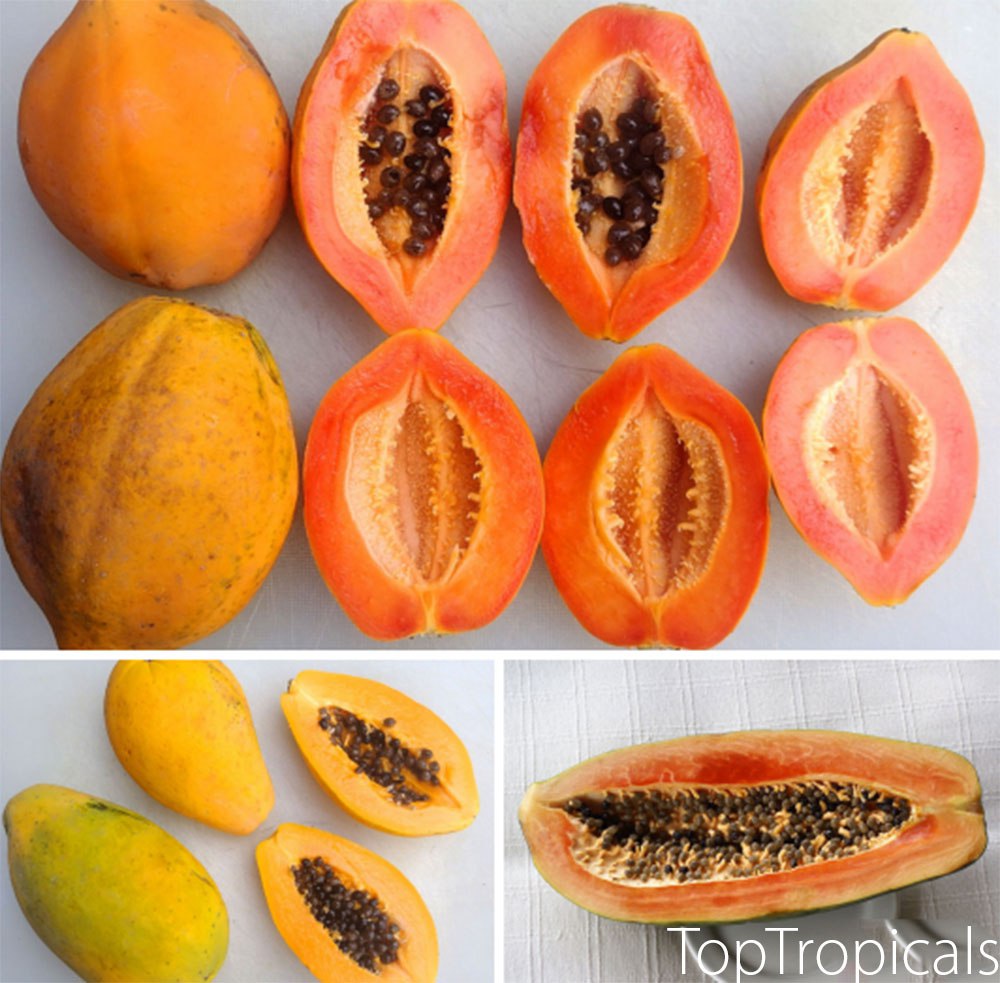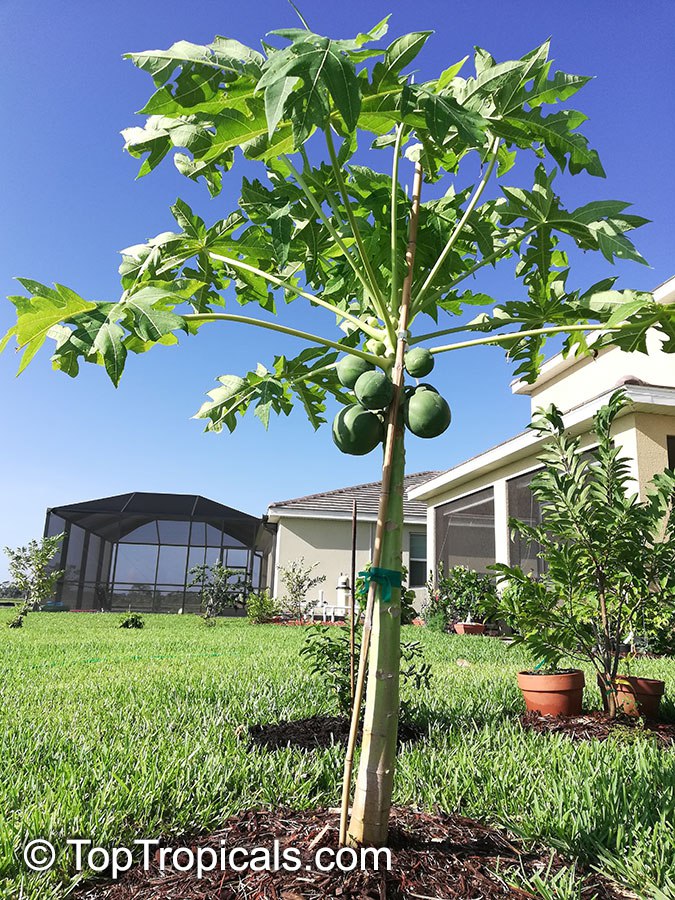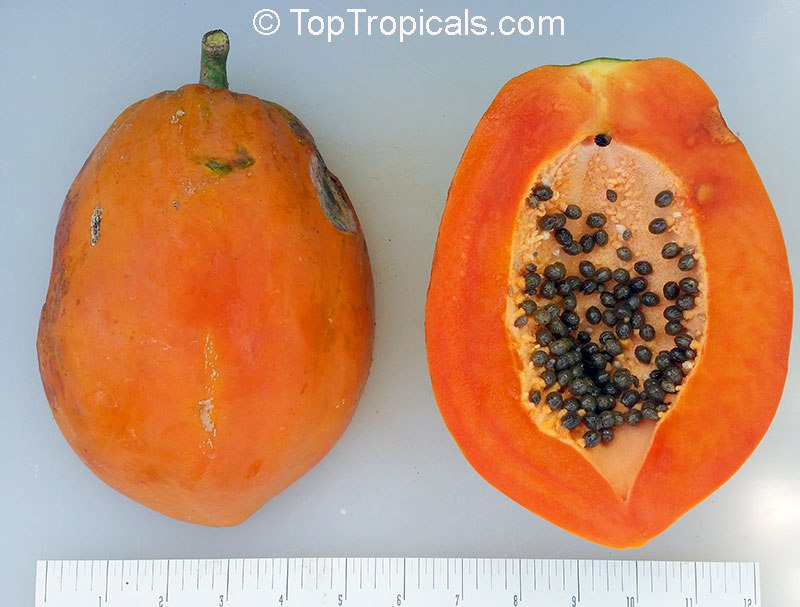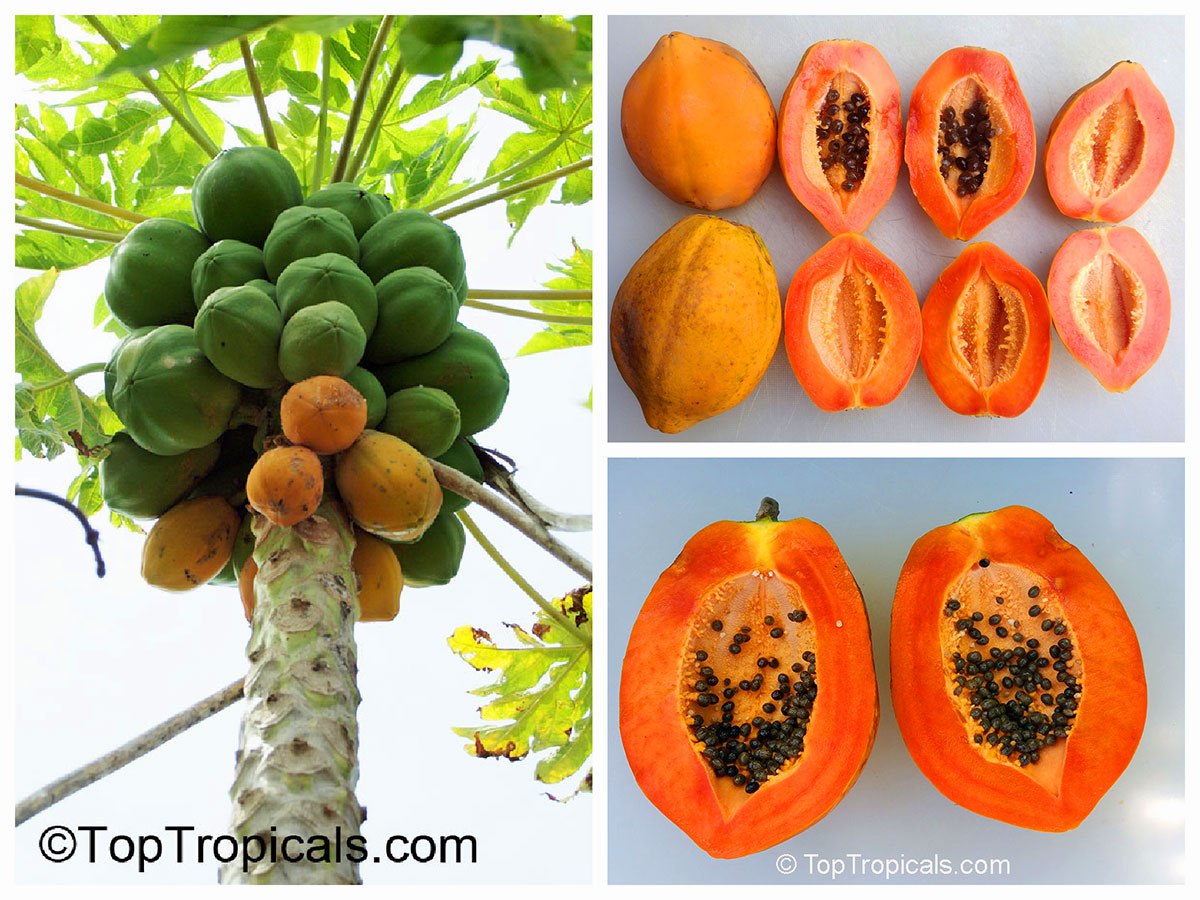Garden Blog - Top Tropicals
Date:
Carefree
Garden:
How easy is it to grow a Papaya tree?
Q: What is the easiest to grow fruit tree? It must tolerate, heat, rains, and hurricanes! I live in Florida.
A: Papaya is the easiest to grow fruit tree. In our garden in Florida, newly planted Papaya trees survived several hurricanes, frosts, drought and heat, and keep producing year around!
We all enjoy eating Papaya fruit every day. It is great for digestion and is a perfect naturally sweet, healthy snack. Even our PeopleCats love Papaya. Check out this short video how our cat Cash is begging for his daily Papaya treat!
Why do we love Papaya? Fun facts about Papaya:
Not a tree: Papaya is technically a giant herb with a single, straight trunk that can grow up to 30 feet tall.
Gender flexible: Papaya plants can change their gender based on environmental conditions. This complex mechanism ensures better adaptability.
Cold and wind resistant: Papayas can withstand light freezes and strong winds, making them surprisingly hardy for a tropical plant.
Solo cultivars: These smaller, round or oval papayas are incredibly sweet and less susceptible to fruit flies.
How to grow a Papaya Tree: Practical Guide
Papaya is one of the fastest fruiting plants to grow. Often starting production the same year from planting a seed, papayas are ideal for gardeners seeking quick rewards. Many dwarf varieties reach only 6-8 feet tall, yet produce large crops of full-sized fruit that are easy to harvest. Papaya trees are space-efficient, making it possible to plant multiple trees in even small gardens. Plant 2-3 different cultivars to enjoy year-round harvests of healthy, delicious fruit.
How Easy Are Papaya Trees to Grow?
Papaya trees are exceptionally easy to grow. Technically a large herbaceous
plant rather than a true tree, they are resilient and adaptable. They can
tolerate light freezes and even hurricane winds without significant damage.
Additionally, many varieties are self-fertile, but planting multiple trees
encourages better pollination and higher yields.
What Light Levels and Soil Types Are Ideal?
Papayas thrive in full sunlight, so choose a sunny spot in your garden or
balcony. They prefer well-draining, fertile soil enriched with organic matter.
Add compost or manure to improve soil quality and ensure healthy growth.
Avoid waterlogged areas as papayas are sensitive to standing water.
How Much Watering Is Required?
Papayas need some watering to thrive, especially during the growing and
fruiting seasons. Water deeply once or twice a week, depending on your climate,
ensuring the soil remains moist but not waterlogged. Mulching around the base
helps retain moisture and regulate soil temperature.
Growing Papayas in Containers
Papayas can be successfully grown in large containers, making them ideal
for gardeners in cooler regions or those with limited space. Choose a container
at least 7 gallons in size with good drainage. Use a rich, well-draining
potting mix, and place the container in a sunny location. Select dwarf varieties
to keep the plant manageable and productive.
Health Benefits of Papaya
Papaya is considered a superfood due to its high nutritional value. Rich in
the enzyme papain, it aids digestion and promotes gut health. Papaya is also
an excellent source of vitamins A, C, and E, as well as antioxidants that
boost immunity and overall wellness. Additionally, papaya leaves can be used as
wraps for cooking meats, naturally tenderizing them.
Papayas are a low-maintenance, high-reward addition to a Southern garden or greenhouse collection, whether in the ground or in a container. Their fast growth, year-round fruiting potential, and health benefits make them a must-have for gardeners and fruit enthusiasts alike.
Photo above: For small gardens, limited space, or container culture, choose dwarf varieties that remain compact and short (5-8 ft tall) while producing a tremendous amount of fruit! Most productive dwarf varieties: Red Vietnam, Lady Red, TR Hovey, Wan Deng. Semi-dwarf: Waimanalo, Sunrise.
The truth about Papaya:
1) it is grass, and
2) it can go transgender!
The secret facts of Papaya's private life.
- 📌 Did you know that Papaya technically is not a tree? It is a large herbaceous plant, usually with a single, straight trunk that can reach 30 feet!
- 📌 Many dwarf varieties available in selection, reaching only 6-8 ft tall, but producing large crops of full size fruit - they are easy to harvest.
- 📌 Papaya trees have very complex gender mechanism, but the bottom line is - the tree can chance its sex based on conditions! Many varieties are self-fertile, but it always recommended to plant a few trees for cross-pollination and better yield.
- 📌 The sweetest Papaya is from so called "Solo" cultivars: the fruit is usually round or oval, on a smaller side, but super sweet.
- 📌 Fruit from Solo cultivars are not susceptible to fruit flies.
- 📌 Being officially a tropical plant, Papaya is pretty cold resistant and can withstand light freeze without significant damage.
- 📌 Surprisingly, Papayas are also hurricane-resistant plants and can take strong winds without damage. They still stand when other trees are down!
- 📌 Papaya is one of the Super-Foods thanks to papain - a natural enzyme containing in this fruit. Papaya fruit offers the best digestive aid! Eat some papaya after each meal to maintain healthy digestion.
- 📌 Try papaya leaf wraps for cooking meats - you won't need a meat tenderizer!
- 📌 Easy to grow trees, Papayas don't take any space in the garden, but bring so much goodness into your life!
🛒 Shop Papaya Trees
#Food_Forest
🏵 TopTropicals
How to have fresh Papaya fruit year around
- 🟠 Many people include Papaya fruit in their daily diet because of its healing properties for digestive system. You can eat Papaya fresh as a tasty dessert, add to salads ripe or green, use fruit and leaf wraps in cooking - possibilities are endless.
- 🟠 Buying papaya fruit from the store every day can become costly. So you can plant your own tree - Papayas are heavy producers. But like with many fruit trees, the question may arise:
❓ What to do with so many fruit at once, and where to get the fruit when it's out of season?
- 🟠 The answer is: plant several varieties. Different Papaya cultivars, similar to Mango and Avocado, have different crop seasons.
- 🟠 If you want to enjoy fresh delicious Papaya fruit year around, plant several Papaya varieties in your garden that have different ripening times.
- 🟠 Papaya tree doesn't take any room in your garden: similar to a palm tree, all its leaves/crown is up high, so you can plant as many trees as you want in a very limited space and still use the room under Papaya tree for other plants.
For example:
Waimanalo - ripens from July to October and sporadically throughout the year.
Sunrise - ripens from January through September and sporadically throughout the year.
Maradol - ripens from August through March and sporadically throughout the year.
🛒 Limited time offer: Papaya collection - 3 trees for half price!
Shop Papaya varieties
📚 Learn more from previous posts:
The secret facts of Papaya's private life
Top 3 most wanted Papaya varieties
#Food_Forest
🏵 TopTropicals
How to grow tons of fruit in limited space - its incredible!
100 Papaya trees in 6"x100" strip
- 🍊 Yesterday we planted 100 Papaya trees in 6"x100" strip of the garden. That’s right - 100! This year, we’ll have BILLIONS and BILLIONS of fruit. Unbelievable! You should do it too. And here's how.
- 🍊 Want to grow more fruit trees? Different varieties? But look at your space - it's never enough! What can you do? Most people have no clue. But we do.
- 🍊 "Fruit cocktail trees" - great idea, right? Different varieties grafted onto one tree. Used to be very popular, especially citrus. But guess what? Doesn’t work well. The strongest variety takes over, dominates - very unfair.
- 🍊 The best solution? It's called "One Hole Planting." Genius! Just plant several varieties in the SAME hole. Each variety gets its own root system - no fighting, no losers. Just winners.
- 🍊 The absolute best candidates? Papaya Trees! (Carica papaya). They grow tall, straight, strong - just like a palm tree!
- 🍊 Here’s the trick: plant several varieties together. Both male and female trees (you thought male papaya was useless? Plant it in, and watch what happens!). It's the best way! Saves space, supercharges pollination, maximizes fruit production. You get different flavors, non-stop harvests.
- 🍊 Watch the video - 14 huge holes, 100 trees! It’s going to be HUGE! And guess what? We'll be back in just a few weeks - showing off the harvest! Stay tuned!
📚 Learn more from previous posts:
- 🟡 How to have fresh Papaya fruit year around
- 🟡 Top 3 most wanted Papaya varieties
- 🟡Carefree Garden: practical Guide to Growing Papaya.
- 🟡10 best fruit trees to grow in Florida and Southern landscapes. # 7: Papaya Tree.
- 🟡more posts about #Papaya
🛒 Shop Papaya Trees
#Food_Forest #Papaya #How_to
🔴 Join 👉 TopTropicals
What is the biggest papaya fruit on the smallest tree?
Papaya TR Hovey
🍈 We discovered an amazing Papaya variety. It is called TR Hovey. This dwarf tree is only 4-5 ft tall and yet produces giant sweet papayas size of a melon!
📚More about Papaya from earlier posts:
Carefree Garden: How Easy Is It to Grow a Papaya Tree?
Top 10 fruit you'll ever need for your health benefits: #4 Papaya
Top 10 fast-fruiting trees: #6. Papaya
How to have fresh Papaya fruit year around
Top 3 most wanted Papaya varieties
The truth about Papaya
Papayas contain a secret enzyme
🛒 Shop Papaya trees
#Food_Forest #Papaya
🔴 Join 👉 TopTropicals
Top 10 fruit youll ever need for your health benefits:
#4 Papaya 🍊
🟡 Papaya is a popular ingredient in salads, smoothies, and tropical desserts.- 🟡It contains enzymes like papain that aid digestion and reduce bloating.
- 🟡It is high in vitamin C and vitamin A, the antioxidants in papaya may protect against heart disease and reduce cancer risk.
📚 More about Papaya from previous posts:
- 💋 How to have fresh Papaya fruit year around
- 💋Top 3 most wanted Papaya varieties
- 💋The secret facts of Papaya's private life
- 💋Papaya-Citrus Marinade
- 💋Top 10 fast-fruiting trees: Papaya (Carica papaya)
🛒 Plant a Papaya Tree
#Food_Forest #Remedies #Papaya
🔴 Join 👉 TopTropicals
Top 10 fast-fruiting trees:
#6. Papaya (Carica papaya)
Papaya is probably the fastest fruiting tree that can start production the same year from planting a seed. Many dwarf varieties available in selection, reaching only 6-8 ft tall, but producing large crops of full size fruit - they are easy to harvest. Plant 2-3 Papaya trees of different cultivars that fruit at different times of the year and enjoy heavy crops of healthy fruit year around! Another benefit - this tree doesn't take much space in the garden, you can plant as many as you want.
📚 Learn more from previous post:
- 💋 How to have fresh Papaya fruit year around
- 💋Top 3 most wanted Papaya varieties
- 💋The secret facts of Papaya's private life
- 💋Papaya-Citrus Marinade
- 💋Top 10 fast-fruiting trees
🛒 Shop Papaya varieties
#Food_Forest
🔴 Join 👉 TopTropicals
How to eat a papaya?
😂 Cut it open, scoop out the seeds (they're not part of the fun), peel off the skin, and chop it up. Now enjoy the tropical sweetness – no passport required!
🎥 Or, if you are desperate and have no time for prep – do it like Cash in the video!
📚More from previous posts:
Why do we love Papaya?
How easy to grow is Papaya tree?
Top 10 fruit you'll ever need for your health benefits: #4 Papaya
Top 10 fast-fruiting trees: #6. Papaya
How to have fresh Papaya fruit year around
Top 3 most wanted Papaya varieties
The truth about Papaya
Papayas contain a secret enzyme
🛒 Shop Papaya trees
#Food_Forest #PeopleCats #How_to #Papaya
🔴 Join 👉 TopTropicals
Date:
Discover 10
best fruit trees to grow
in Florida and Southern landscapes
Q: We recently moved into our new home in Florida, and the property is a great size - 5 acres - but it currently has no trees, just a few palms. I'm looking to plant some productive fruit trees to start building our own Food Forest. What fruit trees would you recommend as a good starting point?
A: With five acres of space, you have a fantastic opportunity to create a fruitful garden that can provide for your family for many years to come. Below are our top recommendations for must-have, easy-to-grow fruit trees that thrive in Florida's climate, grow quickly, and start producing right away.
1. Mango Tree
Mango trees (Mangifera indica) are a must-have for any Florida garden, embodying the essence of the Sunshine State with their delicious and nutritious fruit packed with vitamins and fiber. These fast-growing, low-maintenance trees thrive with minimal water and are heat-tolerant. Grafted varieties produce high-quality, fiberless fruit in just 2-3 years, while dwarf "condo" mangoes are perfect for smaller spaces or containers. While young trees need frost protection, mature trees handle cold better. Grafted mangoes offer rich taste that you won't find in commercially grown, fibrous varieties, ensuring a sweet and vibrant harvest from your own garden.
2. Avocado Tree
The Avocado tree (Persea americana) is an essential addition to any tropical or subtropical garden. Known for its health benefits and superfood status, it's a favorite fruit that's not only productive but also a beautiful ornamental tree. Some avocado varieties are more cold-tolerant than mango trees, with the ability to survive temperatures below 25F. While many enjoy growing avocado from seed, only grafted trees guarantee quality fruit and immediate production, as seedlings can take 7-8 years to bear fruit. To successfully grow avocado, ensure good drainage by planting on a raised mound (4-6 inches) and keep the soil consistently moist. There are also compact varieties like Wurtz and Fuerte that thrive in containers or small spaces, making them ideal for patios and small gardens.
3. Tropical Cherries
Tropical cherries, such as Cherry of the Rio Grande (Eugenia aggregata), Grumichama (Eugenia brazilensis), Pitomba (Eugenia luschnathiana), and Black Surinam Cherry (Eugenia uniflora var. Lolita), are popular and easy-to-grow fruit trees that offer fast growth and excellent fruit production. These compact, versatile trees thrive in both the ground and containers, starting to produce fruit almost immediately. Eugenias are low-maintenance, requiring minimal water, thriving in various soil types, and being pest-free. They are heat-tolerant and can endure cool winters, surviving light frosts. Birds love the fruit, but don't worry - there will always be plenty for everyone.
4. Barbados Cherry Tree
Barbados Cherry (Malpighia glabra), also known as Acerola, is a tropical cherry renowned for having the highest vitamin C content of any fruit. This nutrient-packed fruit is perfect for jellies, jams, and freezing without losing its vitamin C. The Barbados Cherry is a fast-growing, dense shrub that fruits multiple times a year, providing abundant harvests for gardeners seeking quick results. It thrives in alkaline soil, tolerates drought, and is relatively cold-hardy, withstanding light freezes. Birds love the fruit, making it a great addition to wildlife-friendly gardens. The dwarf variety, Nana, with its small leaves and fruit, is perfect for containers, borders, or even bonsai, adding ornamental value to any space.
5. Noni Tree
The Noni Tree (Morinda citrifolia) is a top superfood plant that makes a fantastic addition to any Southern garden. Known for its numerous medicinal benefits, Noni fruit offers anti-inflammatory properties, relief from arthritis, and support for conditions like diabetes, metabolism, and weight loss. It's even believed to help fight cancer. Noni trees grow quickly and begin producing fruit within 2 years from seed. This tough, resilient plant thrives in poor soil, endures summer heat, and withstands drought conditions. Despite its tropical appearance, Noni is surprisingly cold-hardy, recovering well after leaf damage in cooler weather. In addition to its health benefits, the Noni tree has ornamental value, with large, waxy leaves and unique fruit, where the flower appears to grow directly on the fruit!
6. Macadamia Nut Tree
The Macadamia Nut Tree (Macadamia integrifolia) is a fantastic addition to any garden, allowing you to grow these delicious, high price tag, nutrient-rich nuts right at home. These trees are cold-hardy, grow quickly, and thrive in all Florida soil types. Once established, they are productive and can tolerate both flooding and drought. Older trees can survive colder winters, while young trees need protection from temperatures below 25-26F. Macadamia trees like plenty of water and a special fertilizer program, including liquid fertilizers and microelements, to ensure healthy root development and optimal production. Aside from being rich in healthy fats, vitamins, and minerals, macadamia nuts offer numerous health benefits, such as improved digestion, heart health, weight management, and blood sugar control. They are also packed with tocotrienols - antioxidants which may protect against cancer and brain diseases.
7. Papaya Tree
Papaya trees (Carica papaya) are resilient, easy to grow, and produce fruit year-round. Rich in papain, a digestive enzyme, papayas are a superfood that promotes gut health. These fast-growing trees often begin producing fruit within the same year they're planted, providing quick rewards for gardeners. Many varieties, especially dwarf papayas, are space-efficient, reaching only 6-8 feet tall while still yielding large crops, making them perfect for small gardens. Surprisingly hardy for a tropical plant, papayas can withstand light freezes and strong winds (tested in hurricanes!). While they are self-fertile, planting 2-3 different cultivars improves pollination and increases yields. "Solo" cultivars, with their smaller, round or oval fruits, are sweet and less susceptible to fruit flies.
8. Guava Tree
Guava trees are beloved for their flavorful fruit, commonly used in juices, drinks, and desserts. Popular varieties include Tropical Guava (Psidium guajava), Cattley Guava (Psidium littorale), Cas Guava (Psidium friedrichsthalianum), and Pineapple Guava (Feijoa sellowiana). Despite their tropical nature, guavas are surprisingly cold-hardy, suitable for cooler climates and occasional frost. These trees thrive in moist conditions and can tolerate some flooding, while their compact growth makes them easy to maintain at any height or shape. Guavas are fast-fruiting, often producing fruit within a year of planting, and even some varieties in 1 gal containers. The dwarf Nana variety is perfect for container culture, producing full-sized fruit in a compact form. Guava trees are mostly pest-resistant, though mealybugs may require occasional treatment with neem oil in humid, rainy areas. Planting multiple guava trees ensures a continuous supply of fresh, juicy fruit and delicious guava juice for everyone to enjoy.
9. Jackfruit Tree
The Jackfruit tree (Artocarpus heterophyllus) is a striking, fast-growing tree known for producing the largest fruit grown on a tree, making it a showstopper in any garden. Nutrient-packed and often used as a meat substitute in South Asian cuisine, Jackfruit is also delicious in curries, chutneys, and as dehydrated chips. These trees grow quickly, have large waxy leaves, and can be maintained at a compact height of 7-8 feet, making them ideal for smaller spaces and easier cold protection. Despite being a tropical species, Jackfruit trees are relatively cold-tolerant and can survive light frost (although on the account of production volume), with established trees being more hardy than seedlings. Jackfruit trees begin producing fruit within 3-4 years from seed, and varieties come true to seed, eliminating the need for grafting, though it can be done for specific varieties.
10. Loquat Tree
The Loquat tree (Eriobotrya japonica) is a fast-growing, drought-tolerant, and highly cold-hardy tropical fruit tree that thrives in Florida gardens. Loquats are heavy producers, with juicy, aromatic fruit that ripens from early spring to early summer, offering a delicious apricot-like flavor. This compact tree is perfect for small gardens, beginners, and those with limited space. Loquats are undemanding, thriving in any soil and withstanding summer heat, winter cold, heavy rains, and occasional flooding. Nutrient-rich, they are high in sugar, acids, vitamins B and C, minerals, and pectin. Loquats are versatile, enjoyed fresh or used in fruit salads, jams, jellies, chutneys, pies, sauces, and even wine-making, and they are often used as a natural sweetener.
Ten best fruit trees to grow in Florida and Southern landscapes
# 7: Papaya Tree.
- 🍊 Papaya Trees (Carica papaya) - are resilient, easy to grow, and deliver year-round fruit.
- 🍊 Superfood Benefits: Rich in papain, a digestive enzyme that promotes gut health.
- 🍊 Fast Fruiting: Papayas often start producing the same year they're planted, offering quick rewards for gardeners seeking quick rewards.
- 🍊 Space-Efficient: Many varieties, especially dwarfs, reach only 6-8 feet tall yet produce large crops, ideal for small gardens.
- 🍊 Cold and Wind Resistant: Papayas can withstand light freezes and strong winds, making them surprisingly hardy for a tropical plant.
- 🍊 Self-Fertile, but Better with Multiple Trees: Planting 2-3 different cultivars ensures better pollination and higher yields.
- 🍊 Solo Cultivars: Smaller, round or oval papayas are sweet and less susceptible to fruit flies.
📚 Learn more from previous posts:
- 🟡about #Papaya
- 🟡Carefree Garden: practical Guide to Growing Papaya.
- 🟡10 best fruit trees to grow in Florida and Southern landscapes
🛒 Shop Papaya Trees
#Food_Forest #Papaya
🔴 Join 👉 TopTropicals


